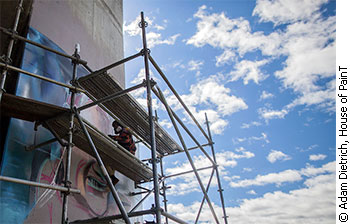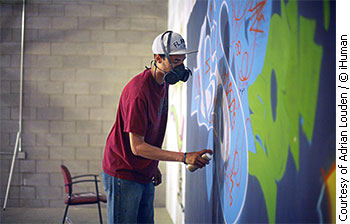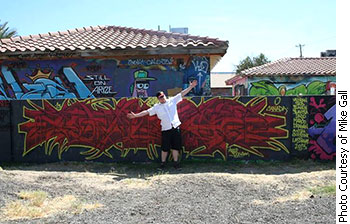Tags
Related Posts
Share This
Painting the town red: Ottawa’s graffiti scene
A masterpiece or a master crime?

At the Houe of PainT Festival in September, the graffiti artist known as Chemis, from the Czech Republic, worked on the Dunbar Bridge.
What was once profoundly considered an antisocial act of vandalism, graffiti today is gradually becoming more accepted by communities across Canada. Cities such as Vancouver, Toronto and Montreal have already commissioned various graffiti artists to paint murals along buildings, subway stations and traffic signal boxes.
But while some cities have been more accommodating, with commissions mounting to thousands of dollars, the capital city of Canada remains somewhat reluctant.
“We still get the age-old ‘Is graffiti art?’ in 95 per cent of debates,” said Mike Gall, a graffiti artist for 15 years in Ottawa. “The western world seems to have a problem with separating the act from the product, so they have trouble examining the artistry of what’s created.”
Gall, 32, is also a writer and the graffiti programmer for House of PainT, an organization that rejoices in urban and hip-hop culture in Ottawa. This past September, House of PainT celebrated its tenth anniversary at its usual venue under the Dunbar Bridge, Ottawa’s first legal graffiti wall. Despite some mixed responses, according to Gall, the organization has seen a dramatic increase in the volume of participants and attendees since its inception.
Peeling back the layers
Described as “complex” and “little understood” by author Yvette Farkas, graffiti rose in popularity within a typically rebellious young demographic in the 1970s. That frontier has since shifted toward the centre, with experts eager now to legally define graffiti.
“I think there’s a couple of different trends,” said Jacqueline Kennelly, a sociology professor at Carleton University who focuses on youth, education and urban studies. “On the one hand is still this view of graffiti as problematic, as kind of criminal behaviour that needs to be punished. On the other hand, I think there’s been an embrace of the potential for graffiti as public art — as potentially having a political message or at least as being something that young people can use to claim their space in communities.”
However, the city of Ottawa remains firm. Since the launch of the city’s graffiti management program in 2003, any graffiti reported or witnessed will be removed almost immediately.
“The bottom line is, graffiti is vandalism — it’s put on the surface without permission,” said Paul McCann, the project coordinator of the graffiti management program. “[For] the capital of Canada, all that defacing is not acceptable.” According to McCann, 90 percent of reported graffiti is tags and scribbles left by young amateurs. Under Ottawa’s Graffiti Management By-law, as indicated on the city’s website, offenders can face fines of up to $615.
‘Slowly but surely, in the city that fun forgot.’ — Mike Gall, Ottawa graffiti activist
Still, there have been some efforts here to follow the trend of other cities that use legal mural paintings to offset graffiti vandalism. In 2010, the city of Ottawa partnered with the Ottawa Police Service and House of PainT for the Paint it Up! mural program, which tries to redirect at-risk youth away from illegal activities and into supervised mural paintings. Paint it Up! is still running in Ottawa and receives $50,000 a year from the city.
An education in deviance
For Mike Gall, the solution lies in educating citizens about graffiti culture. He says this will in turn ease negative stereotypes and de-escalate the long-lived debate. The idea he suggests is for professional artists to convey their knowledge to other aspiring artists. This way, graffiti art can likely lead to “a much higher end product” that benefits from editing and “more policing,” he says.

As founder of the Edmonton-based Aerosol Academy, Adrian Louden educates at-risk youth on the uses and abuses of graffiti art.
In harmony with Gall’s philosophy is Adrian Louden, a graphic and industrial designer, working in one of Edmonton’s bronze foundries.
Louden, 27, is also a graffiti artist and the creator of a program called the Aerosol Academy. The program teaches youth about graffiti and art, including teaching the history, practices, techniques and consequences of illegal graffiti. Over the past summer, Louden partnered with iHuman Youth Society, a local group that works with at-risk youth, to teach them in a four-day program.
According to Louden, the response from the course was quite positive. “[Graffiti] can be a good creative focus that can steer them away from some of the negative influences in their environments. The art form and culture was invented mostly by youth, so it has always been something youth were into.”
‘For the capital of Canada, all that defacing is not acceptable.’ — Ottawa city staffer Paul McCann
Others have even found ways to transform graffiti into a form of activism and educating a cause. Julie Forand, 30, came up with a project this past summer, called Sprout Guerrilla.
In her senior year studying industrial design at Ontario College of Art & Design University, Forand’s goal was to “make urban sustainability accessible and fun.” She decided to take the idea of traditional aerosol graffiti art, and replace it with Moss Graffiti — planting all natural moss onto walls in whatever design.
“Traffic pollution often gets trapped at pedestrian level in the streets, so street level is an ideal place for moss to be grown,” she said. “And the creative aspect of graffiti is just plain fun!”
Since then, moss kits have become available online for others to order and participate in the green cause. “The response has been good so far,” said Forand. “The concept is new to a lot of people so it’s a great opportunity to create conversation around urban greening.” With the success so far, the Toronto-based company will run several more community moss art projects this year.
Progress in acceptance

In Las Vegas, Ottawa graffiti artist Mike Gall poses in front of his piece in honour of his mother. It reads “Janice.”
Although Ottawa city laws remain unmoved, organizations such as House of PainT are undiscouraged, and see the growing opportunities for graffiti culture in public opinion. “Slowly but surely, in the city that fun forgot,” Gall said.
The organization is currently getting ready for another big project planned for February 2014: House of PainT has partnered with the Embassy of Germany in Canada to mark the 25th anniversary of the fall of the Berlin Wall. City dwellers will have the opportunity to witness Canadian and German artists at work to commemorate this significant occasion.
“Seeing the city accept House of PainT like it has pushes me to invest more of my time making life better in my community,” Gall said. “Seeing the progress and positive change over the years gives me hope that it will encourage others to get off the couch and see what the people creating in Ottawa have to offer.”
Anna Khimasia, an art history instructor who teaches a course on graffiti at Carleton University, remains skeptical over the potential success of graffiti in Ottawa, as opposed to other cities. “Ottawa is a bureaucratic town — it doesn’t have a lot of diversity,” she said. “It’s taken a long time for it to grow even partly as diverse as Vancouver, Toronto and Montreal.”
But regardless of locale, Khimasia said we are in an exciting and progressive time for graffiti as an art form generally. “[Graffiti is] not considered a subculture; it’s been totally normalized,” she said. “To be a graffiti artist is to be an artist like any other.”
Home-page photo © Adam Dietrich, courtesy of House of PainT.





